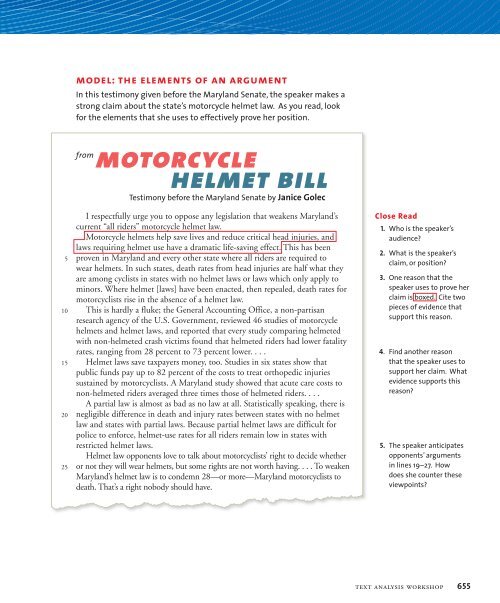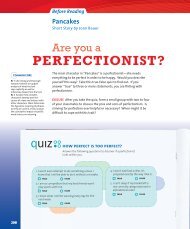Create successful ePaper yourself
Turn your PDF publications into a flip-book with our unique Google optimized e-Paper software.
model: the elements of an argument<br />
In this testimony given before the Maryland Senate, the speaker makes a<br />
strong claim about the state’s motorcycle helmet law. As you read, look<br />
for the elements that she uses to effectively prove her position.<br />
5<br />
10<br />
15<br />
20<br />
25<br />
from<br />
motorcycle<br />
helmet bill<br />
Testimony before the Maryland Senate by Janice Golec<br />
I respectfully urge you to oppose any legislation that weakens Maryland’s<br />
current “all riders” motorcycle helmet law.<br />
<strong>Motorcycle</strong> helmets help save lives and reduce critical head injuries, and<br />
laws requiring helmet use have a dramatic life-saving effect. This has been<br />
proven in Maryland and every other state where all riders are required to<br />
wear helmets. In such states, death rates from head injuries are half what they<br />
are among cyclists in states with no helmet laws or laws which only apply to<br />
minors. Where helmet [laws] have been enacted, then repealed, death rates for<br />
motorcyclists rise in the absence of a helmet law.<br />
This is hardly a fluke; the General Accounting Office, a non-partisan<br />
research agency of the U.S. Government, reviewed 46 studies of motorcycle<br />
helmets and helmet laws, and reported that every study comparing helmeted<br />
with non-helmeted crash victims found that helmeted riders had lower fatality<br />
rates, ranging from 28 percent to 73 percent lower. . . .<br />
<strong>Helmet</strong> laws save taxpayers money, too. Studies in six states show that<br />
public funds pay up to 82 percent of the costs to treat orthopedic injuries<br />
sustained by motorcyclists. A Maryland study showed that acute care costs to<br />
non-helmeted riders averaged three times those of helmeted riders. . . .<br />
A partial law is almost as bad as no law at all. Statistically speaking, there is<br />
negligible difference in death and injury rates between states with no helmet<br />
law and states with partial laws. Because partial helmet laws are difficult for<br />
police to enforce, helmet-use rates for all riders remain low in states with<br />
restricted helmet laws.<br />
<strong>Helmet</strong> law opponents love to talk about motorcyclists’ right to decide whether<br />
or not they will wear helmets, but some rights are not worth having. . . . To weaken<br />
Maryland’s helmet law is to condemn 28—or more—Maryland motorcyclists to<br />
death. That’s a right nobody should have.<br />
Close Read<br />
1. Who is the speaker’s<br />
audience?<br />
2. What is the speaker’s<br />
claim, or position?<br />
3. One reason that the<br />
speaker uses to prove her<br />
claim is boxed. Cite two<br />
pieces of evidence that<br />
support this reason.<br />
4. Find another reason<br />
that the speaker uses to<br />
support her claim. What<br />
evidence supports this<br />
reason?<br />
5. The speaker anticipates<br />
opponents’ arguments<br />
in lines 19–27. How<br />
does she counter these<br />
viewpoints?<br />
text analysis workshop 655





